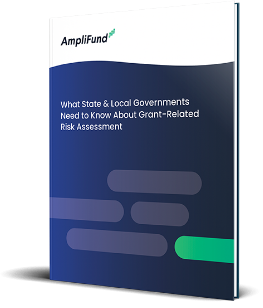You got the grant. Now what?
Grant seekers tend to get their grant funding from many sources, and not all of those sources have the same compliance and reporting requirements. Without a concrete project plan to manage these different funding streams, your grant-funded projects may struggle to meet not only compliance requirements, but also, and most importantly, your intended outcomes.
You’ve done the difficult work of proposing a project that was compelling enough to be funded, which is excellent news. But compelling proposals don’t necessarily always smoothly transition into well-functioning projects, especially for organizations with smaller teams. Grant seekers often face similar challenges when it comes to grants management, such as:
- A lack of resources to dedicate to grants
- Not enough people to build a full grants team
- High rates of staff turnover
- Difficulty maintaining accountability over Federal grant regulations
- Issues managing separate awards that fund a variety of services
- Issues with audits and fund spend
- Lack of access to tools that other award recipients may have
When one or two of these challenges are present, they tend to lead to more challenges down the road. If you’re struggling with high turnover, you know how difficult it can be to create a well-structured team. Without a well-structured grants team in place, it is difficult to maintain accountability. If everything is not properly documented from internal processes to expense reports, you could potentially perform poorly in the single audit and jeopardize future funding.
How do you get ahead of this and create something replicable?
This guide aims to offer some tips so you can pivot from proposing an ideal project to creating a workable and replicable project plan, allowing you to get closer to your outcomes with each award.
Here are some key steps to go through when you win an award.
Create a Team
Let’s start by tackling some challenges that grant seekers often face when it comes to creating a grants team. Like we discussed briefly before, grant seekers often don’t have a lot of resources to dedicate to grants, or always enough people on staff to build a full grants team.
A small team can still produce big results.
In an ideal world, you would have considered personnel allocation prior to submitting a grant proposal. Projects are routinely proposed based on an ideal conception of them, and not the reality of the situation the project will be managed within, however. In either case, you’ll want to begin by assembling your project team.
Take a hard look at your existing team. Assess the strengths and skills of those team members to ensure you have the right stakeholders on that list. Try making a checklist that will help you document your goals and details about your grant team, including:
- Who these key team members are.
- Team members from outside of the grant team (programmatic and/or fiscal employees) who may be involved in the grant process.
- The responsibilities that will be needed for each role on the team.

In many cases, one person can fill multiple roles on a grant team.
When you have a clearer understanding of who you are able to pull in to help manage the project, and what roles you will need them to fill, you will be able to see where there may be gaps in knowledge or capacity that you will have to close.
Talking to your team members about their capacity and abilities may help with this. You may also find that you need to shift priorities for existing projects to create capacity.
If you are able to procure technology to help build capacity for managing an award, that is ideal.
Create a Plan
Now that you’ve assessed your team and have a clear understanding of what resources are needed to manage this project and maintain compliance, spend some time creating an overall project plan outline that you can present to the team to get everyone on the same page.
Preparing to create this plan with your team beforehand will give you an opportunity to refresh yourself on the project your organization proposed that won the award.

Your goal here should be to guide the project in the right direction, not to plan it in its entirety by yourself.
The most effective way to do this, is to hold an internal kick-off meeting with the project team, assign individual tasks and goals, and plan your monthly spend.
Hold a kickoff meeting
The kick-off meeting sets the tone for the overall project. It’s a great opportunity to bring all of the project’s stakeholders together, establish a foundation for good communication practices, and discuss the overall scope of the project and its needs with the team. Kick-off meetings allow you to set expectations for the team, allows the team to come to consensus on the details of the project, and gives them a better understanding of each of their responsibilities.
Make sure you have the right stakeholders at this meeting.
Create an agenda for the meeting to ensure there is adequate time to do the following:
- Provide an overview of the project plan outline you have created
- Discuss the roles that will need to be filled
- Outline the basic responsibilities you’ll need commitments for
- Set key milestone dates you can use to benchmark project progress
- Ask and answer questions
- Discover what is still needed for this project to be successful
Assign individual tasks and goals
At the kick-off meeting, you can begin the process of maintaining accountability by assigning individual tasks and goals for the project. It can be helpful to make a table or a matrix for this. A sample table has been provided to get you started here.
You should only assign one person to each individual element that will need to be reported on. This is done with the intent of building accountability into the project plan. If multiple people are involved in a step, no one individual can be accountable for that task. Even with a small team, it is important that these responsibilities are clearly defined, and documented in the project plan.
Plan your monthly spend
Make a plan for your projected monthly spend for the project. You can measure your reporting against this planned spend to see if there is a potential issue before it becomes an official issue.
Create a Policy
Take this opportunity to create internal policies on reporting to ensure you’re on track with your monthly spend. Establishing standard reporting structures once a grant is awarded will provide financial oversight and can help your organization adhere to a timeline with milestones that can be used for benchmarking.

You should be reporting internally on a monthly basis even if the grant does not require it.
Create internal policies on reporting
You should set a policy in place that requires team members to report back to the grant coordinator or manager on a monthly basis. If you have a grants management system or a tool to help you do this, your GMS should do this for you. If you don’t have a GMS, you will need to create a system or a structure for this process that will need to be documented.
Reporting on a monthly basis will allow you to catch problems early. For example, if you’re unsure if an expenditure can be accounted for, monthly reporting will allow you time to get in touch with your Program Officer or Manager who will be able to help clarify this for you.
As you track expenditures, be sure to have backup information required by the Uniform Grant Guidance (UGG) for auditing purposes, and to ensure you have a complete grant record. This will pay dividends throughout the life of the project, and especially during award closeout.
Create a Process
Create structures for financial and performance reporting
Financial reporting and performance reporting are tied to one another. This means that for the purposes of reporting, program performance is often tied to budget expenditure and financial data in addition to project milestones. The financial information needed to measure that progress, however, is not always readily available for real-time visibility, especially if you are only completing the quarterly or annual reports required by your funder.
 By creating a review process that requires specific expenditures to be approved and documented internally, you will have a more accurate picture of your project’s budget adherence and overall progress.
By creating a review process that requires specific expenditures to be approved and documented internally, you will have a more accurate picture of your project’s budget adherence and overall progress.
You may already have a specific process in use for another funding stream or award, and if so, try to keep the reporting structure similar to that to provide internal reporting consistency.
The Program Officer should be in charge of keeping track of everything related to this process in a centralized location, and every step of this reporting process should be documented in case of staff turnover.
Create an Archive
Document, document, document
In order to effectively monitor program performance, progress, and plan for a successful audit, you want to ensure you have documented everything throughout the life of the grant.
When we say “everything,” we really do mean everything.
For example, if you have expenditures that weren’t properly documented, even if they were allowable, this could be considered a misuse of funds. The way to avoid this is by keeping everything related to the grant documented and in a centralized location.
If you have been diligent about your internal reporting practices, you will have a lot of information that will need to be centralized in one location.
Centralizing your grant-related information including your policies, processes, and programmatic data requirements and standards will help you improve organizational transparency and maintain compliance. Centralization helps ensure all of your program’s records are readily accessible for auditing purposes, effective closeout, and most importantly, for monitoring your outcomes.
Create an Outcome
By setting your grant-funded project up for success with clear expectations, policies, and processes, you will also set yourself up for a successful audit and award closeout.
By keeping thorough records of all of your programmatic data, you will be able to demonstrate the impact your program made to the community and brought about intended change. These changes have positive effects for your organization as well due to the fact that running a successful project increases the likelihood that you will be funded for another down the road.
The most significant effect of creating structured plans to manage your project is, quite literally, creating change in the world.
Measuring programmatic performance doesn’t only have to be for maintaining compliance. Don’t just report back on progress to your funders. Make sure your team gets a performance report as well. It can be helpful for morale and drive you all forward in your mission together.
The last tip we have for you as you prepare for award closeout is simple, but easy to forget: in those moments when you feel overwhelmed by financial data and reporting requirements, try to focus on the good your project is doing as well.
Your mission is what matters.
We’re here to help along the way.
 Check out the entire Grant Seeker Best Practices eBook Series. #1 – “How to Write an Effective Grant Proposal” here and #3 – “How to Closeout an Award” here.
Check out the entire Grant Seeker Best Practices eBook Series. #1 – “How to Write an Effective Grant Proposal” here and #3 – “How to Closeout an Award” here.
*Photo by Glenn Carstens Peters on Unsplash






